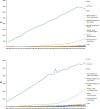End of Affirmative Action-Who Is Impacted Most? Analysis of Race and Sex Among US Internal Medicine Faculty
- PMID: 38100008
- PMCID: PMC11254878
- DOI: 10.1007/s11606-023-08554-0
End of Affirmative Action-Who Is Impacted Most? Analysis of Race and Sex Among US Internal Medicine Faculty
Abstract
Background: For over 50 years, the United States (US) used affirmative action as one strategy to increase diversity in higher education including medical programs, citing benefits including training future public and private sector leaders. However, the recent US Supreme Court ending affirmative action in college admissions threatens advancements in the diversity of medical college faculty.
Objective: Our study evaluated the demographic trends in Internal Medicine (IM) faculty in the US by assessing sex and race/ethnicity diversity to investigate who is likely to be impacted most with the end of affirmative action.
Design: Longitudinal retrospective analysis SUBJECTS: IM faculty from the Association of American Medical Colleges faculty roster from 1966 to 2021 who self-reported sex and ethnicity MAIN OUTCOMES: The primary study measurement was the annual proportion of women and racial/ethnic groups among IM faculty based on academic rank and department chairs.
Results: Although racial/ethnic diversity increased throughout the era of affirmative action, African American, Hispanic, and American Indian populations remain underrepresented. White physicians occupied > 50% of faculty positions across academic ranks and department chairs. Among the non-White professors, Asian faculty had the most significant increase in proportion from 1966 to 2021 (0.6 to 16.6%). The percentage of women increased in the ranks of professor, associate professor, assistant professor, and instructor by 19.5%, 27.8%, 25.6%, and 26.9%, respectively. However, the proportion of women and racial/ethnic minority faculty decreased as academic rank increased.
Conclusion: Despite an increase in the representation of women and racial/ethnic minority IM faculty, there continues to be a predominance of White and men physicians in higher academic ranks. With the end of affirmative action, this trend has the danger of being perpetuated, resulting in decreasing diversity among IM faculty, potentially impacting patient access and health outcomes.
Keywords: affirmative action; diversity; equity; internal Medicine; patient outcomes.
© 2023. The Author(s), under exclusive licence to Society of General Internal Medicine.
Conflict of interest statement
Dr. Faisal Khosa received the Don Rix Physician Leadership Lifetime Achievement Award (2022); B.C. Achievement Foundation – Mitchell Award of Distinction (2022); University of British Columbia – Distinguished Achievement Award for Equity, Diversity & Inclusion (2022); and Vancouver Medical Dental & Allied Staff Association – Equity, Diversity & Inclusion Award (2022). In addition, Dr. Khosa is the recipient of the Health Professional-Investigator Award of the Michael Smith Foundation for Health Research (HPI-2022-2876).
Figures







Similar articles
-
Gender, Race, and Ethnicity of US Academic Ophthalmology Faculty and Department Chairs From 1966 to 2021.JAMA Ophthalmol. 2024 Aug 1;142(8):742-748. doi: 10.1001/jamaophthalmol.2024.2375. JAMA Ophthalmol. 2024. PMID: 38990520 Free PMC article.
-
Two decades of little change: An analysis of U.S. medical school basic science faculty by sex, race/ethnicity, and academic rank.PLoS One. 2020 Jul 31;15(7):e0235190. doi: 10.1371/journal.pone.0235190. eCollection 2020. PLoS One. 2020. PMID: 32735593 Free PMC article.
-
Race and Ethnicity, Gender, and Promotion of Physicians in Academic Medicine.JAMA Netw Open. 2024 Nov 4;7(11):e2446018. doi: 10.1001/jamanetworkopen.2024.46018. JAMA Netw Open. 2024. PMID: 39602123 Free PMC article.
-
Academic surgery: Faculty gender and racial trends through an intersectional lens.Women Health. 2025 Jul;65(6):533-544. doi: 10.1080/03630242.2025.2523256. Epub 2025 Jul 4. Women Health. 2025. PMID: 40616286 Review.
-
The association between ethnicity and delay in seeking medical care for chest pain: a systematic review.JBI Database System Rev Implement Rep. 2016 Jul;14(7):208-35. doi: 10.11124/JBISRIR-2016-003012. JBI Database System Rev Implement Rep. 2016. PMID: 27532797
Cited by
-
Doubling Down on Diversity: Enhancing the Recruitment and Retention of Underrepresented Academic Physicians in a Post-affirmative Action Era.J Gen Intern Med. 2024 Jul;39(9):1541-1543. doi: 10.1007/s11606-024-08741-7. J Gen Intern Med. 2024. PMID: 38564161 Free PMC article. No abstract available.
-
Faculty diversity trends in physical medicine and rehabilitation by gender, race, and ethnicity in the United States, 1977-2021.PM R. 2025 Mar;17(3):319-329. doi: 10.1002/pmrj.13291. Epub 2024 Dec 24. PM R. 2025. PMID: 39719856 Free PMC article.
-
Global insights on diversity, equity, and inclusion-perspectives and experiences from musculoskeletal radiologists of the International Skeletal Society DEI Committee.Skeletal Radiol. 2025 Sep;54(9):1811-1820. doi: 10.1007/s00256-025-04926-1. Epub 2025 Apr 12. Skeletal Radiol. 2025. PMID: 40220144 Review.
References
-
- Chung A, Kruzel J. US Supreme Court rejects affirmative action in university admissions. Reuters [Internet]. 2023 Jun 29 [cited 2023 Jun 30]; Available from: https://www.reuters.com/legal/us-supreme-court-strikes-down-university-r...
-
- Jones N, Marks R, Ramirez R, Rios-Vargas M. 2020 Census Illuminates Racial and Ethnic Composition of the Country [Internet]. United States Census Bureau. [cited 2023 Oct 23]. Available from: https://www.census.gov/library/stories/2021/08/improved-race-ethnicity-m....
MeSH terms
LinkOut - more resources
Full Text Sources

